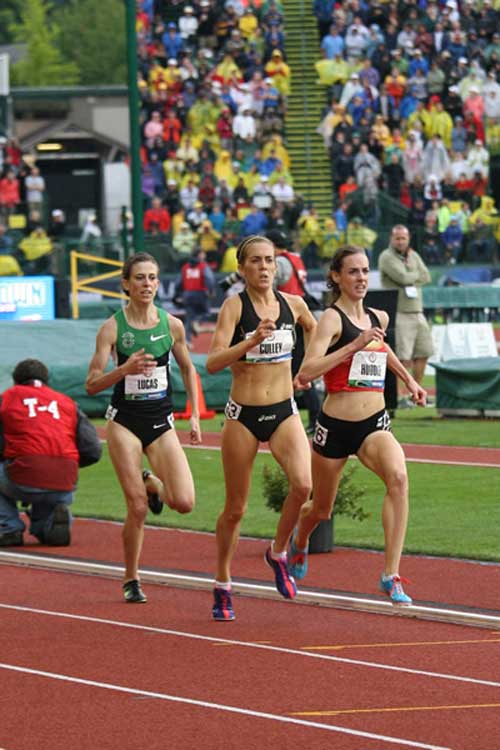The TV Trials
by Jim
Dunaway
Thursday, June 28 ****
On the second four-day weekend of the 2012
Olympic Trials, I was finally able to
see the NBCSN coverage, which many of you have been seeing since the Trials started.
I saw it with a group of very track-knowledgeable friends, which to me at least
makes a surprisingly large difference in viewing: because of cross-talk it is
harder to hear all the TV commentary, because the viewers in the room are supplying
their own commentary.
That’s something the producer and the
commentators might want to be thinking about, both in their planning and when
on the air: keep it simple, make it clear.
Today’s NBCSN telecast featured three
distance finals: the men’s 3,000-meter steeplechase, and the women’s and men’s
5,000 meters, in that order. It also featured a new expert commentator, Craig
Masback, who before he was the chief executive of USATF (1997-2008) was a
3:52.02 miler.
I thought the coverage was very good. There
were more calls and more depth than had been evident in last weekend’s races.
In fact, there were only two (fairly minor) things I could quibble about. And being me, I will.
One was in the steeplechase, where
co-favorite Daniel Huling, after leading for much of the way, came apart in the
last lap and faded to seventh. I don’t think that Craig or Tom Hammond
mentioned where Huling finished, and I think it was an important part of the
story of the race.
Some might think that it would be cruel to
track down Huling right after the race and ask him, “What happened?” But a
collapse like that (a 74-second last lap!) is news. My mentor, Cordner Nelson,
used to amaze me by going up to an athlete who had failed and ask, “What
happened?” But I learned that’s part of the reporting process. In this case, of course, it’s
quite possible that Huling didn’t want to talk, or couldn’t be located in the
post-race confusion.
But it was an exciting race, and the story of
Evan Jager winning the Trials in only his fourth-ever steeplechase was very
well reported.
The other glitch (from my point of view) was
when long shot Kim Conley, who led for much of the first half of the race, was
passed by Molly Huddle. There was an apparent assumption in the commentary that
Conley, having had her moment in the sun, would fade back into the pack. But,
of course, she didn’t; instead, she stayed in the lead group for most of the
rest of the race, and then edged past Julia Lucas in the final stride for third
place and a spot on the team..
What I don’t think was right was the assumption
that Conley was a “morning glory” who would be passed by others and drop back
into the trailing group. I know that this often happens in distance races, but
it didn’t happen this time, and I’d rather see the announcers stick to
reporting instead of predicting.
This reporting vs. predicting issue is one of
the philosophical issues of track coverage on TV, and my viewpoint is obviously
somewhat different from the guy who’s actually calling the shots.
The men’s 5,000 final was perfectly covered
— when with 800 meters to go the favored foursome of Galen Rupp, Bernard
Lagat, Lopez Lomong and Andrew Bumbalough separated themselves from the field. The
last lap was a mano a mano between Rupp
and Lagat, with Lagat taking the lead at the top of the stretch only to be
re-passed by Rupp and both ran 52-second last 400s.
That’s when the predicting model works, and
the reality follows the assumptions to the letter. Great race, great coverage.
The other featured event was the women’s 200
heats, where we followed the continuing drama (read: soap opera) of the Allyson
Felix-Jenobah Tarmoh dead heat into yet another chapter. It’s beginning to remind
me of the fourth-grader’s one-line book report, “This book tells me more about
penguins than I care to know.”
#####
Author

Larry Eder has had a 52-year involvement in the sport of athletics. Larry has experienced the sport as an athlete, coach, magazine publisher, and now, journalist and blogger. His first article, on Don Bowden, America's first sub-4 minute miler, was published in RW in 1983. Larry has published several magazines on athletics, from American Athletics to the U.S. version of Spikes magazine. He currently manages the content and marketing development of the RunningNetwork, The Shoe Addicts, and RunBlogRun. Of RunBlogRun, his daily pilgrimage with the sport, Larry says: "I have to admit, I love traveling to far away meets, writing about the sport I love, and the athletes I respect, for my readers at runblogrun.com, the most of anything I have ever done, except, maybe running itself." Also does some updates for BBC Sports at key events, which he truly enjoys. Theme song: Greg Allman, " I'm no Angel."
View all posts





















